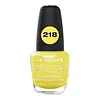What's inside
What's inside
 Key Ingredients
Key Ingredients

 Benefits
Benefits

No benefits
 Concerns
Concerns

 Ingredients Side-by-side
Ingredients Side-by-side

Ethyl Acetate
PerfumingButyl Acetate
MaskingPolyethylene Terephthalate
Adipic Acid/Neopentyl Glycol/Trimellitic Anhydride Copolymer
Nitrocellulose
Styrene/Acrylates Copolymer
Isopropyl Alcohol
SolventAlcohol Denat.
AntimicrobialSucrose Acetate Isobutyrate
Silica
AbrasivePolybutylene Terephthalate
Benzyl Alcohol
PerfumingDiethylhexyl Adipate
EmollientN-Butyl Alcohol
PerfumingSynthetic Fluorphlogopite
Benzophenone-1
UV AbsorberPolyurethane-11
Trimethyl Pentanyl Diisobutyrate
Diacetone Alcohol
MaskingStearalkonium Bentonite
Gel FormingCalcium Sodium Borosilicate
Dimethicone
EmollientCalcium Sodium Phosphosilicate
Tin Oxide
AbrasiveMica
Cosmetic ColorantCI 77891
Cosmetic ColorantCI 15850
Cosmetic ColorantCI 15880
Cosmetic ColorantCI 77510
Cosmetic ColorantCI 77266
Cosmetic ColorantCI 19140
Cosmetic ColorantCI 60725
Cosmetic ColorantCI 77007
Cosmetic ColorantIron Oxides
CI 75170
Cosmetic ColorantEthyl Acetate, Butyl Acetate, Polyethylene Terephthalate, Adipic Acid/Neopentyl Glycol/Trimellitic Anhydride Copolymer, Nitrocellulose, Styrene/Acrylates Copolymer, Isopropyl Alcohol, Alcohol Denat., Sucrose Acetate Isobutyrate, Silica, Polybutylene Terephthalate, Benzyl Alcohol, Diethylhexyl Adipate, N-Butyl Alcohol, Synthetic Fluorphlogopite, Benzophenone-1, Polyurethane-11, Trimethyl Pentanyl Diisobutyrate, Diacetone Alcohol, Stearalkonium Bentonite, Calcium Sodium Borosilicate, Dimethicone, Calcium Sodium Phosphosilicate, Tin Oxide, Mica, CI 77891, CI 15850, CI 15880, CI 77510, CI 77266, CI 19140, CI 60725, CI 77007, Iron Oxides, CI 75170
Butyl Acetate
MaskingEthyl Acetate
PerfumingNitrocellulose
Phthalic Anhydride/Trimellitic Anhydride/Glycols Copolymer
Acetyl Tributyl Citrate
MaskingIsopropyl Alcohol
SolventStearalkonium Hectorite
Gel FormingCitric Acid
BufferingTitanium Dioxide
Cosmetic ColorantIron Oxides
CI 19140
Cosmetic ColorantCI 47005
Cosmetic ColorantCI 42090
Cosmetic ColorantCI 77007
Cosmetic ColorantCI 15850
Cosmetic ColorantCI 15880
Cosmetic ColorantMica
Cosmetic ColorantCI 77510
Cosmetic ColorantCI 77742
Cosmetic ColorantButyl Acetate, Ethyl Acetate, Nitrocellulose, Phthalic Anhydride/Trimellitic Anhydride/Glycols Copolymer, Acetyl Tributyl Citrate, Isopropyl Alcohol, Stearalkonium Hectorite, Citric Acid, Titanium Dioxide, Iron Oxides, CI 19140, CI 47005, CI 42090, CI 77007, CI 15850, CI 15880, Mica, CI 77510, CI 77742
Ingredients Explained
These ingredients are found in both products.
Ingredients higher up in an ingredient list are typically present in a larger amount.
We don't have a description for Butyl Acetate yet.
Ci 15850 is the pigment color red. It is an azo dye and created synthetically.
Azo dyes need to be thoroughly purified before use. This allows them to be more stable and longer-lasting.
This ingredient is common in foundations, lipsticks, and blushes. This color is described as brown/orangey red.
It has many secondary names such as Red 6 and Red 7. According to a manufacturer, Red 6 usually contains aluminum.
Learn more about CI 15850We don't have a description for CI 15880 yet.
CI 19140 is also known as Tartrazine. Tartrazine is a synthetic dye used in cosmetics, foods, and medicine to add a yellow color.
Tartrazine is created from petroleum and is water-soluble.
Some people may experience allergies from this dye, especially asthmatics and those with an aspirin intolerance.
Learn more about CI 19140This pigment is called Ultramarine blue lazurite. It gives a saturated blue color, but can be used to create other colors as well.
According to the manufacturer, it is usually made from kaolin, sodium sulfate, sodium carbonate, sulfur, and charcoal.
This ingredient is used to impart a blue color. It is not water-soluble.
It goes by two different names:
1. Ferric Ferrocyanide: a synthetic dark blue pigment
2. Ferric Ammonium Ferrocyanide: a synthetic blue pigment, also called Prussian blue
In the EU, both of these colors must be labeled as 'CI 77510'.
Learn more about CI 77510Ethyl Acetate is a fragrance.
Isopropyl Alcohol is more commonly known as rubbing alcohol. It is most commonly used as a solvent, meaning it helps other ingredients dissolve.
This ingredient is an astringent alcohol. Astringent alcohols may also irritate skin as they high amounts may strip away your skin's natural oils.
Other types of astringent alcohols include:
According to the National Rosacea Society based in the US, you should be mindful of products with these alcohols in the top half of ingredients.
Any type of sanitizing product will have high amounts of alcohol to help kill bacteria and viruses.
Learn more about Isopropyl AlcoholMica is a naturally occurring mineral used to add shimmer and color in cosmetics. It can also help improve the texture of a product or give it an opaque, white/silver color.
Serecite is the name for very fine but ragged grains of mica.
This ingredient is often coated with metal oxides like titanium dioxide. Trace amounts of heavy metals may be found in mica, but these metals are not harmful in our personal products.
Mica has been used since prehistoric times throughout the world. Ancient Egyptian, Indian, Greek, Roman, Aztec, and Chinese civilizations have used mica.
Learn more about MicaWe don't have a description for Nitrocellulose yet.
This ingredient is a combination of red, black, and yellow iron oxide pigments. This combination of colors is usually found in foundation, because it results in a "skin" color.